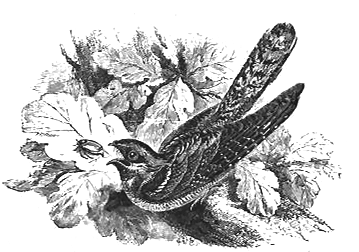
‘Better than many more melodious singers, I love the monotonous music of the goatsucker. He has but two notes, and after sustaining the higher for thirty seconds or more, drops half a tone upon the lower and so concludes his burst of song. He loves the twilight, for his great eyes hardly endure full day, and he haunts the stony places in the open scrub at forest edge. His long-drawn purr, rising and falling and throbbing through the dusk of June, is precious in itself, and also because it wakens remembered vigils with lonely dingles in the gloaming, with still pools wherein stars were mirrored, and with the faces of grey stone-heaps fading into darkness.’ (Phillpotts, 1919, p.6).
If you are really lucky when walking near any of the central plantations (Fernworthy, Bellever or Soussons) of a summer evening you may still hear the strange whirring call of the goatsucker. Its official name is Caprimulgus europaeus, (Caprimulgus is Latin for Goatsucker – Caper = goat, Mulego = to milk) but the bird’s other name is – the Nightjar. In ancient folklore it was believed that the nightjar would suck the milk from goats’ teats, hence the name – goatsucker. Needless to say there is no grain of truth in the suggestion that nightjars suck the milk of goats or any other lactating animal as is prosaically noted below:
‘The harmless, unoffending Goatsucker, from the time of Aristotle down to the present day, has been in disgrace with man. Father has handed down to son, and author to author, that this nocturnal thief subsists by milking the flocks. Poor injured little bird of night, how sadly hast thou suffered, and how foul a stain has inattention to facts put upon thy character! Thou hast never robbed man of any part of his property nor deprives the kid a drop of milk.’, (Waterton, 1826, p.324).
It is thought that the reason the bird has been accused of sucking milk is that it will often lie on the ground amongst cattle, sheep and the like and await a feast of insects that will be drawn to the animals. It may well have been that someone once observed the goatsucker taking a fly off a goat’s teat and simply assumed it was after the milk. It has also been accused of causing a disease in young calves once known as puckeridge, this being contracted by means of the bird pecking at the animals, Another name that the goatsucker goes by is the ‘Fern Owl’, this is due to the fact that it does look something like a small owl and can be frequently be seen flying amongst the ferns at night. Alternatively you can occasionally hear the goatsucker referred to as a ‘Churn Owl’.

One distinctive trait of the goatsucker is that when perching on a branch or log it will sit horizontally along its length as opposed to crosswise, with there head facing downwards, possibly this is to enhance its very effective camouflaging plumage.
The bird arrives from Africa around the end of April/beginning of May and has usually departed by late August, early September although there have been reports of them over-wintering. As suggested by Phillpotts the favourite habitat of the goatsucker is on the forest edges and over heath, scrub and moor. The goatsucker nests on the ground where it will usually lay two eggs, (sometimes twice in a year), thanks to its plumage it remains well hidden whilst on the nesting platform. The feathers perfectly imitate tree bark which when roosting during the daytime make it very hard to spot but being nocturnal it is at dusk when the bird is most active. However its activities are not just confined to nightime as being crepuscular it can also be seen at dawn. The goatsuckers diet consists of large insects, ie. moths and beetles, which predominantly it will catch in flight, this is simply done by flying with mouth agape and simply hoovering up any passing insects. Unless you are particularly lucky the only evidence of a goatsucker is its rather mechanical ‘churring’ song. On the rare occasions when I have heard it the sound reminded me of a demented woodpecker continually drilling on a tree.
On Dartmoor the goatsucker population does tend to fluctuate, this may well be due to the age and density of its woodland habitat. When the conifer plantations were first established there was an increase in the bird numbers but as the trees grew and the undergrowth thickened their numbers dropped. This was probably due to the fact that the goatsuckers preferred habitat is that of sparse undergrowth not dense brash. As the ‘Devon Biodiversity Plan’ notes: ‘Nightjars are essentially heathland birds, requiring low, sparse vegetation in which to nest, and also find the heath-like conditions that arise in conifer plantations shortly after they have been clear-felled and replanted a very suitable habitat.’ This decline continued until the 1980s after which there was a steady increase in numbers which coincided with the gradual clearing of the plantations. Today the goatsucker can be heard around Fernworthy, Bellever, Soussons, and Yarner woods to name but some of the locations, (Smaldon, 2005, pp. 120 – 121). Hopefully as more and more of the plantations are felled the numbers will increase further thus providing an eerie end to a days moorland ramble.

Phillpotts, E. 1919. A Shadow Passes, New York, The Macmillan Company.
Smaldon, R. 2005. The Birds of Dartmoor, Falmouth: Isabelline Books.
Waterton, C. 1826. The Quarterly Review, London: John Murray.
 Legendary Dartmoor The many aspects past and present of Dartmoor
Legendary Dartmoor The many aspects past and present of Dartmoor

Nightjars heard at Fernworthy yesterday evening 6.10.2021 at around 17.00hrs. Weather is warm for time of year.